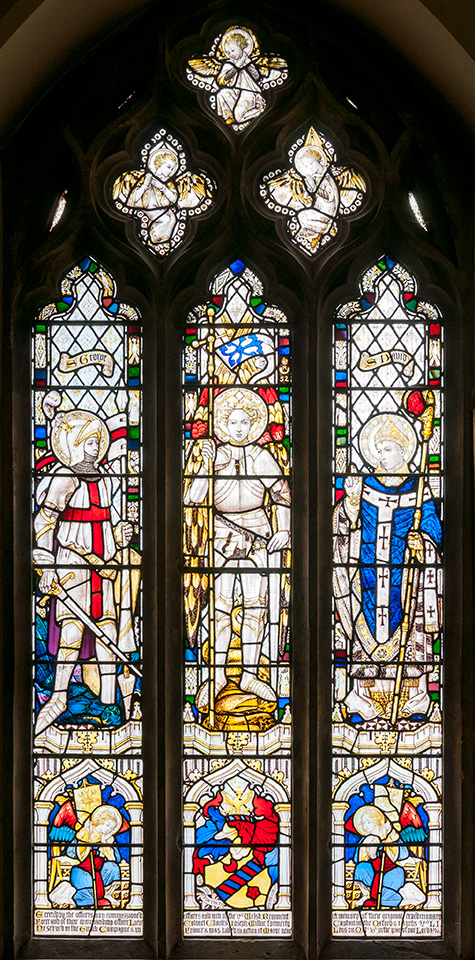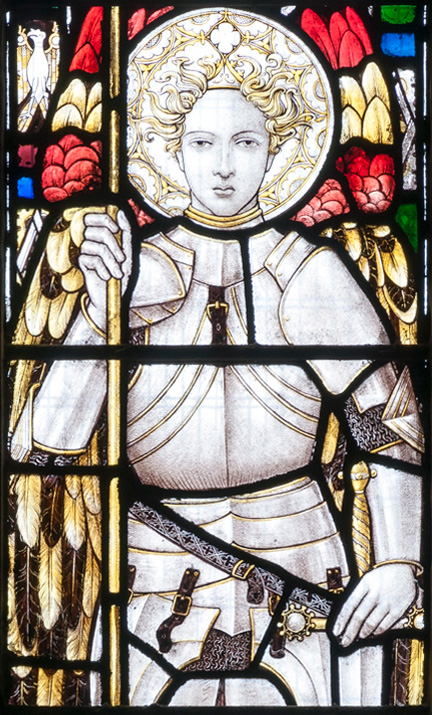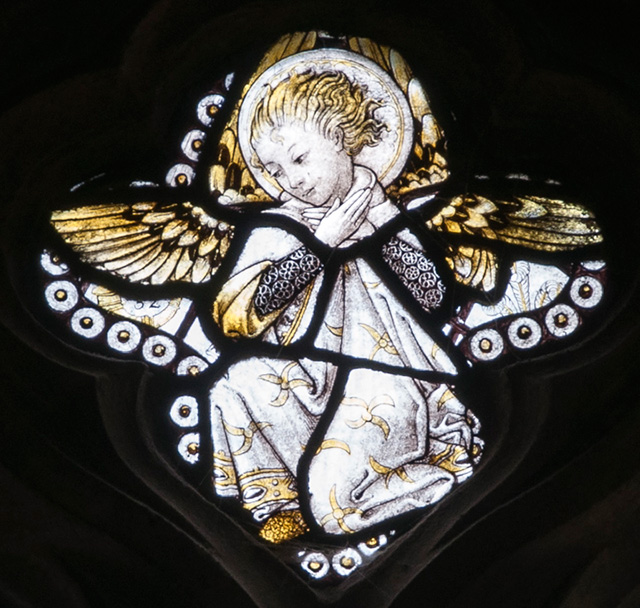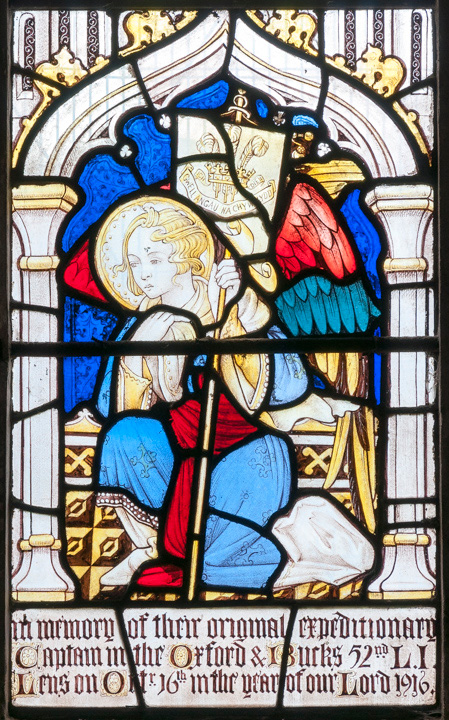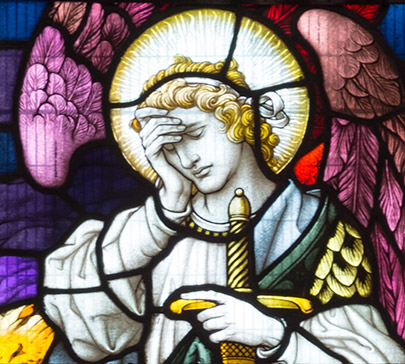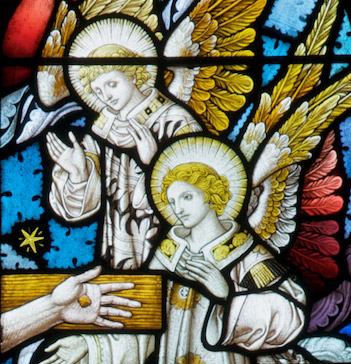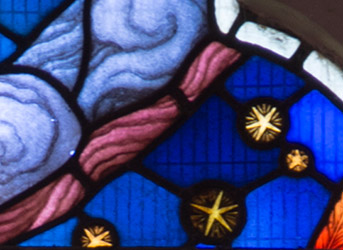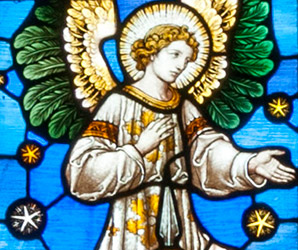Home » Posts tagged 'Arts and Crafts Movement'
Tag Archives: Arts and Crafts Movement
A War Memorial Window by Alice Meredith Williams at Bassaleg
In June 2023 I gave talks at a couple of churches as part of the Churches Unlocked Festival, a series of events across the dioceses of Llandaf and Monmouth. In addition to talks and performances, churches were open to visitors over the weekend and some were open for the whole of the two-week period of the festival.
Giving talks at churches is often a two-way exchange. I can share information on the makers, subjects and commissioning of windows and also glean further information and hear additional stories about the stained glass in these buildings from those that attend.
Having prepared a talk on the windows that can be found at the Church of St Basil, Bassaleg, near Newport, I was unprepared to find a booklet concerning one of the windows produced to mark an event at the church in November 2022. I was delighted to find that the booklet revealed the identity of the artist behind a window that has puzzled me for many years since I first visited the church in 2011.
The window commemorates Lieut Col C.J. Wilkie and officers, NCOs and men of the seventeenth battalion of the Welch Regiment, and has three main figures of the archangel Michael and the saints George and David. At first glance it appears to be a fairly conventional late Gothic Revival war memorial window, with standing figures, angels and heraldry. I included it as an example of the combinations of saints found in First World War memorial stained glass in Stained Glass from Welsh Churches in 2014, although I was uncertain about attributing the window.
In the Buildings of Wales volume for Gwent/Monmouthshire, by the late John Newman and published in 2000, it is suggested that the window was probably by Martin Travers. The aesthetic of the window bears some relation to his work, but Travers’ biographer, Micheal Yelton, had confirmed that the window was not by him. The suggested attribution of the window to Travers was provided by Alan Brooks, and prior to the publication of Stained Glass from Welsh Churches I sent him my photo of the window and asked him about it. Seeing the window again he replied that he was of the opinion that the work could be by J.C.N. Bewsey, and although I had sight of only a few windows by him, I tentatively attributed the window to Bewsey, a former employee at the studio of Charles Eamer Kempe.
I was never very happy with this attribution and looked very hard at it again before including a detail of St David in my book Depicting St David in 2020. I had only come across a few more windows by Bewsey in the intervening time and their style differed from this one. I left the illustration unattributed in the new book and placed it in the context of other windows of St David designed and/or made by Herbert Bryans, Frederick Eden, William Bucknall and Ninian Comper. It seemed quite at home in this company and I mused on these designers working in partnerships with other designers and studios in the first quarter of the twentieth century, making stylistic attributions rather difficult. For example, Eden’s windows were made by James Fisher of Fulham before Eden oversaw the making of his windows in his own studio, presumably with different craftsmen; and although I found a newspaper report identifying the architect William Bucknall as the designer of the figures for the east window at Milford Haven, including David, there was no mention of the studio that had made the window.
The main figures and borders of the window at Bassaleg were all quite conventional, although the faces of the three saints and the angels were more distinctive, especially the heads of St Michael and some of the angels with their slightly wild and tightly curled hair. The colouring was brighter and the white glass whiter than in much stained glass made at the time, in common with work of the same period designed by Eden, Comper and Geoffrey Webb.
The booklet at the church in Bassaleg was produced for a rededication of the window on 26 November 2022. It includes a description of the window from the Western Mail (dated 19 February 1921, following the official unveiling more than two years after the completion of the window), a brief history of the battalion commemorated and information about the making of the window. This reveals that the window was designed by Alice Meredith Williams, whose husband Morris Meredith Williams was also an artist and had joined the battalion in 1915. They had met Lieut Col Charles J. Wilkie, named on the window, and his wife Dora while the battalion trained in Wales and England; Charles and Dora had married in the church at Bassaleg in 1897.
Alice Meredith Williams was commissioned to design the window in 1917 and it was made by E.& C. O’Neill of London, who painted the window and had it made and fixed. Intriguingly, the booklet states that she had consulted J.C.N. Bewsey, so the similarities with his work are not coincidental. He had offered to take the project on, and although Williams kept the commission (despite not charging for her work) she followed some of his advice on the design and he recommended the firm of O’Neill’s to her.
E. & C. O’Neill are not a studio whose work I have come across in Wales before. They made windows for other designers including another former employee of C.E. Kempe, C.E. Tute, who shared his address with them at 165 Grays Inn Road. O’Neill’s also appear to have operated from 103 Grays Inn Road, and by 1914 they were based nearby at 4 Heathcote Street, Mecklenburgh Square.
It is possible that the studio made the only window by Tute that I know of in Wales, the remarkable window of 1897 including St Paul preaching to Caractacus and Bendigeidfran at Llandinam. In 1897 Tute was based at 4 Grays Inn Square, close to the addresses occupied by O’Neill’s, and the studio made a scheme of windows for Tute at Crantock in Cornwall shortly after this date, including an impressive east window.
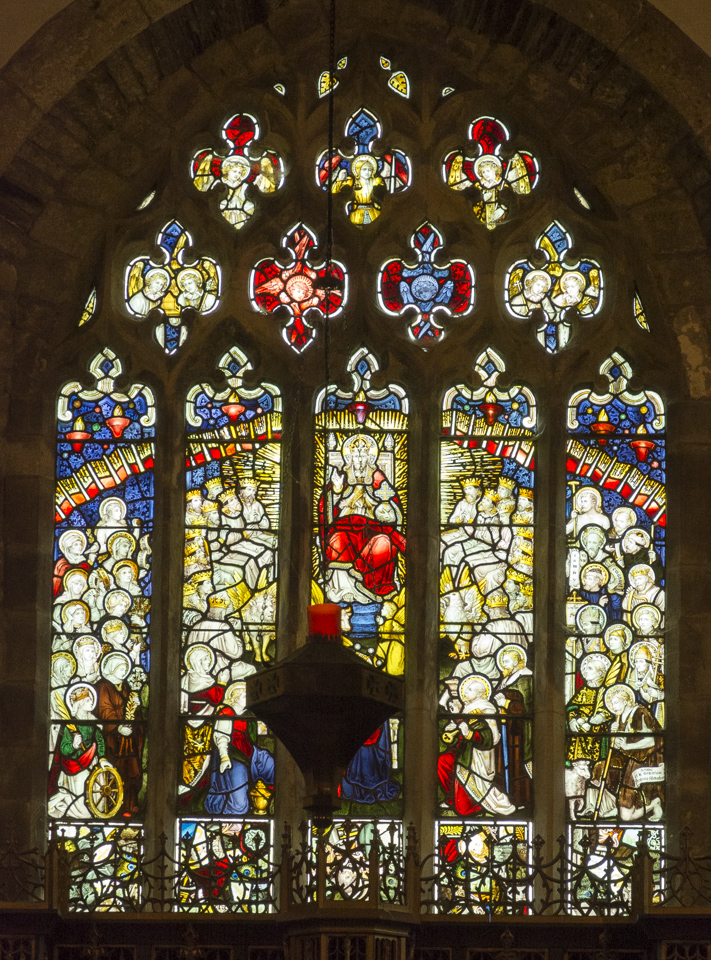
The window at Bassaleg was illustrated in Phyllida Shaw’s excellent book on Alice and Morris Meredith Williams published in 2017, and according to the little booklet at the church Phyllida Shaw attended and spoke at the event for the rededication of the window in 2022. Her book, An Artist’s War: The art and letters of Morris and Alice Meredith Williams, provides ample evidence of the importance of Morris Meredith Williams as a First World War artist, while he served in the same battalion as Charles Wilkie.
Alice Meredith Williams was primarily a sculptor and also drew and painted. Perhaps her most significant work was for the Shrine of the Scottish National War Memorial at Edinburgh Castle, where her the frieze is placed beneath windows by Douglas Strachan; she also made further figures for the building and other powerful monumental sculpture in the aftermath of the First World War. Alice and Morris Meredith Williams designed further windows for churches in Scotland, as well as a set of windows for Bermuda Cathedral. These other windows, as well as others by designed by Morris after Alice died in 1934, look like the work of other makers, probably one of the studios in Scotland that flourished under the influence of the Arts and Crafts Movement in the first half of the twentieth century. Her initial recourse to Bewsey would suggest that the window at Bassaleg was her first window.
The memorial window to Lieut Col C.J. Wilkie and the seventeenth battalion of the Welch Regiment at Bassaleg represents an excellent example of the occasional partnerships and collaborations between particular artists, designers and studios, which can only be tracked down through archival work. These are the kind of windows that usually elude stylistic attribution – in this case it is perhaps the only example of a window by the artist being made by the studio, perhaps making it unique.
Notes
Information on the addresses of E. & C. O’Neill and C.E. Tute is from the ‘Architects and Artists’ section of Sussex Parish Churches; Joyce Little, Stained Glass Marks and Monograms ed. Angela Goedicke and Margaret Washbourn (National Association of Decorative and Fine Art Societies, 2002); and an article on the scheme at Carantoc by Michael G. Swift and Jeni Stewart-Smith on the Cornish Stained Glass site.
For Alice and Morris Meredith Williams, see:
Phyllida Shaw, An Artist’s War: The art and letters of Morris and Alice Meredith Williams (Stroud: History Press, 2017).
Phyllida Shaw, Undaunted Spirit: The Art and Craft of Gertrude Alice Meredith Williams (Independent Publishing Network, 2019).
Two windows at Arthog
The most recent issue of the Journal of Stained Glass (vol. 41, 2017, published 2018) was a special issue dedicated to the work and archives of the Glass House in Fulham, which was the hub of Arts and Crafts stained glass in London in the first half of the twentieth century. Primarily the work of Alan Brooks and Peter Cormack, the volume includes a transcription of their business archives and brief biographies of artists whose windows were made at the Glass House.
There is much to learn from this fascinating material and the accompanying essays, and I looked through the listings to see what might illuminate my research on stained glass in Wales. One entry that stood out was a window by Patience Hallward at the little church at Arthog, near Dolgellau in Gwynedd, and as I was giving a talk on the stained glass of Dolgellau and the surrounding area, I arranged to visit the church. The window was one of two stained glass windows at the church dated, but unattributed, in The Buildings of Wales: Gwynedd (2009).

Arts and Crafts stained glass is often associated with colourful and emotive original artistry and imagery, but the business archives are a reminder that the practicalities of earning a living as a stained glass artist can be rather more mundane. Among the listings for the one of the foremost artists of the medium, Margaret Chilton, are entries for the Marble Hall in City Hall, Cardiff, and the plain glazing of the Church of the Holy Spirit, Ewloe, which were commissions for restorations and repairs, and not original works. The window by Patience Hallward at Arthog is a relatively simple memorial window, with the dedication at the centre of the design. It is beautifully executed, with flowers and sheaves of wheat for decoration, and the lovely textured quality to the glass is typical of an interest in materials that characterised the Art and Crafts Movement. The artist had moved to Arthog with her father, Reginald Hallward, who was also an artist and also designed stained glass, so she would have been a local artist to the church in 1952 when the window was made.

The east window at Arthog is also quite unusual. The three-light window depicts the Annunciation to the Shepherds, but the scene is executed in white glass, with a single piece of pale blue glass used in the lower part of the scene to the left. The detail is provided by paint and silver stain, but the effect is rather monochrome. It reminded me of a series of monochrome windows that I came across relatively recently at Halkyn in Flintshire, which were so unusual that I was sorry to have found them too late to include in my Stained Glass from Welsh Churches (2014). These were listed by Malcolm Seaborne in his survey of Victorian and later stained glass in Flintshire and attributed to Heaton, Butler & Bayne, part of a complete glazing scheme provided for the Church of St Mary, Halkyn, in 1878.

On first sight, the east window at Arthog was also reminiscent of the work of the same firm, and I subsequently compared my photographs of the window with those at Halkyn. Not only was there a discernable similarity of style, but I discovered that the same cartoon had been used at both churches. What was different about the two versions was that the scene at Halkyn is entirely monochrome, with no silver stain. This is something that I have not seen in nineteenth-century stained glass anywhere else, although I am sure other similar windows will have been made elsewhere.

I could not easily measure the width of the panels at Arthog, but it looks as though they were slightly narrower than those at Halkyn, judging by the central panel depicting the two angels. At Halkyn, the arm of the left-hand angel is raised at the edge of the panel, but at Arthog there is not sufficient room, and a hand is folded in from the left. This panel also omits the narrow border found on the right and at either side of both of the flanking panels, to accommodate both hands of the other angel, and the complete halo of the left-hand angel.

This could suggest that the design at Halkyn might have been the original and the window at Arthog a reuse of the cartoon. Seaborne confidently dates the Halkyn glass to November 1878 from a newspaper report, while the Arthog window is of uncertain date, but probably early 1877 or later. It could have been made after the version at Halkyn, or the design might have predated both commissions, and adapted for use at both churches. It would be interesting to see whether the design was used for a coloured stained glass window, or whether it was reserved for largely or wholly monochrome windows as found at these churches.
An Arts and Crafts Window by Clayton & Bell?
Over the last few months I have been collaborating on a book about the stained glass at the Church of St Peter, Lampeter. The initiative for the book came from John Hammond, an expert on stained glass war memorials, and we have written the book together, with publication funded by the church.
 The difference between writing an overview of stained glass in churches and writing a guide that includes all of the windows in the church is that all of the windows need some attention, whether good or bad, and whether or not it is possible to attribute them. In the case of this church, only a few of the windows have signatures, and while the style of some other makers are clear, or have been identified from archives, a handful remained unattributed.
The difference between writing an overview of stained glass in churches and writing a guide that includes all of the windows in the church is that all of the windows need some attention, whether good or bad, and whether or not it is possible to attribute them. In the case of this church, only a few of the windows have signatures, and while the style of some other makers are clear, or have been identified from archives, a handful remained unattributed.
The church does contain a really fine window. The west window is the last monumental work by Wilhelmina Geddes, and the recent biography of the artist by Nicola Gordon Bowe is so detailed that it makes the window perhaps the most comprehensively documented stained glass window in Wales. Since the window contains a figure of the patron of the church, St Peter, it is featured on the cover.
This was the last window added to the church, but the first were windows by Daniel Bell working with Richard Almond in 1870, and also a window that I considered to be by Lavers & Barraud of the same date. Exactly how many of these 1870s windows were also by Daniel Bell (and Richard Almond, with whom he worked until 1875) was uncertain, and given the fact that relatively few windows attributed to Daniel Bell (brother to the better known Alfred Bell) have been published, it has been difficult to make comparisons with other windows by the artist.
 Another window that I was particularly keen to attribute was an attractive First World War memorial. The window is more colourful than much contemporary stained glass, and exhibited unusually loose glass painting in a few areas of the background. The window had no makers’ mark that we were able to discern, and we did our best to go through all of the church and diocesan archives that might be able to date or identify the maker of the window. These efforts failed to find even the date of the window, and I thought that I ought to consult a few experts that I knew in case any suggested attributions came to light.
Another window that I was particularly keen to attribute was an attractive First World War memorial. The window is more colourful than much contemporary stained glass, and exhibited unusually loose glass painting in a few areas of the background. The window had no makers’ mark that we were able to discern, and we did our best to go through all of the church and diocesan archives that might be able to date or identify the maker of the window. These efforts failed to find even the date of the window, and I thought that I ought to consult a few experts that I knew in case any suggested attributions came to light.
After a couple of conversations by email, I was at least approaching the idea that the window was not the work of an individual artist associated with the Arts and Crafts Movement, but was more likely to be by a larger studio, even if it was a livelier window than the usual output of the period. This was then corroborated by a suggestion from Neil Moat that it was the work of John Clement Bell for Clayton & Bell. Given the character of the other windows that I knew of by the firm from around the time of the First World War, this window was something quite different, and unlike anything else that I could find by the firm published online or in print – not that our libraries are full of illustrations of twentieth-century Clayton & Bell windows.
The only other vaguely comparable window by the firm that I knew of was at Beaumaris: a colourful five-light Crucifixion scene. There wasn’t quite the same freshness of colour and painting here, and the painting of the faces was rather different to that in the Lampeter window. However, when I looked at the painting of the angels above, there did seem to be a greater correspondence with the the faces in the Lampeter window. Surely there was a second glass painter at work here in the Beaumaris window (probably more of course).
But the most startling similarity between the two windows was a very tiny detail. Many Clayton & Bell windows, going back well into the nineteenth century, feature little stars that are nonetheless prominent in the design. These two windows also had little stars in the upper parts of the window, and are remarkably similar in execution.
Was the principal glass painter of the Lampeter war memorial working at Clayton & Bell’s studio when he or she painted it? Can we identify the influence of the Arts and Crafts aesthetic (a controversial idea, let alone a definable one) in the output of Clayton & Bell in the 1910s or 20s? Are there many more windows by Clayton & Bell of the period that remain unidentified because of their dissimilarity to what we expect their windows to look like?
The answers to such questions are known by the very few people who have in-depth knowledge of British twentieth-century ecclesiastical stained glass. And it is with sadness that I have to record that in the time since I corresponded with Neil Moat he died suddenly, so now there is now one fewer.
New book of work by Margaret Rope
In an addition to a post about five months ago I mentioned an upcoming exhibition and book about the work of Margaret Rope.
Margaret Agnes Rope (1882–1953) was born in Shrewsbury and was trained in stained glass at Birmingham School of Art under Henry Payne. Her first major work was for Shrewsbury Cathedral and in September an exhibition about her work opens at Shrewsbury Museum and Art Gallery.
The exhibition ‘Heavenly Lights: The Untold Story of Stained Glass Artist Margaret Agnes Rope’ runs from 12 September 2016 to 15 January 2017.
As part of this initiative, Arthur Rope has produced a large-format book of her work with colour illustrations of full windows and details, and a list of her works. It is a considerable achievement, and a reminder of how little has been published on artists of this quality working in stained glass. Faced with a vast gap in developed academic study of the field of stained glass, and art in churches in general, books like this, as well as those by Roy Albutt and Alan Brooks’ study of Francis Spear, have mostly been privately published and rely on the strength of conviction (and financial commitment) of their authors.
These books, from the bottom up, if you like, easily outnumber those from the top down, such as Peter Cormack’s recent Arts and Crafts Stained Glass (2015). This is a book about which I have intended to write on these pages for some time, and may do yet. With such a huge range of material at his disposal, Peter Cormack’s book only illustrates couple of panels and one full window by Margaret Rope and does not have the space to discuss her work in any detail, which ably demonstrates the huge amount of work still to be published on the artists of the Arts and Crafts Movement. There are also those artists and studios earlier in the nineteenth century and later in the twentieth century about whom so little has been written, as well as the contemporaries of Henry Payne and Margaret Rope that have not been connected with the Arts & Crafts ethos, and remain (even) less fashionable.
Margaret Rope of Shrewsbury is announced on its title page as ‘an exhibition of her works in a book’, and since the book lacks a narrative, this is very much the case. Here, the contrast with Nicola Gordon Bowe’s recent book on Wilhelmina Geddes is stark, as her years of research and study have yielded a fascinatingly insightful portrait of the artist offering an absorbing narrative that sheds so much light on the windows.
In the case of Margaret Rope, she left few records, and there is an appeal for more information about her, as well as a team of volunteer archivists gathered by Shrewsbury Museum with the task of researching her life and work. In the meantime, we have a new book of her work, which will be available at the exhibition in September and beforehand via mail order, for details see Arthur Rope’s website.
Dire windows and provincial firms
I have stated elsewhere that Stained Glass from Welsh Churches was not intended as a book of the best stained glass in Wales (and said as much on p. 7 of the introduction). In his review of the book recently published in the Journal of Stained Glass (vol. 38), Peter Cormack goes further, noting the ‘number of feeble or positively dire examples’ that I troubled to include from the later nineteenth and twentieth century, which potentially reinforces a negative view of stained glass that persists among many people. However, negativity, or at least indifference, towards the medium seems more characteristic of art historians than of people in general in my experience. He also claims that the work illustrated reflects ‘the relative poverty of Wales’, and I wonder whether such a claim would have been made if the book had focussed more on high-class works such as big east windows during the same period by Clayton & Bell, Hardman’s, Powell’s and Burlison & Grylls.
In the previous post I quoted another reviewer who commended the ‘even-handedness’ of an inclusive approach to stained glass, and Peter Cormack also praises the inclusion of work by many provincial firms, ‘often for the first time’, in addition to those that are better known. In fact he goes as far as to say that ‘it would be difficult to think of a book that might be more useful to groups such as NADFAS Church Recorders in introducing them to the vast subject of Vicorian and later glass.’ High praise indeed.
There are certainly windows in the book that are poor but which demonstrated something I wanted to convey, and there are others that I couldn’t bring myself to include. There are certainly several in the chapter on late nineteenth-century memorial windows and saddest of all is perhaps the Good Shepherd by A. Seward & Co. of Lancaster which was included to point up the originality of the work of Mary Lowndes and (particularly) Edward Woore in the following chapter on the Arts and Crafts Movement. But my choice of themes for certain chapters was deliberately chosen to include work by lesser known makers, good and bad. Somewhere there will be a window by Seward & Co. that is genuinely cherished by a congregation unaware of my opinions or those of Peter Cormack. They would be probably be interested to know more about the maker and about other windows that the studio made, and these people need books about stained glass as well as art historians primarily interested, for good reasons, in the best that our culture has produced. There is also another reason why the photograph of the Good Shepherd by Seward & Co. was chosen for the book. It is in a church that has long been closed and may never be accessible to the public again, if indeed it survives.
The review in the Journal of Stained Glass is followed by another positive review of my little book on the stained glass at the Church of St Mary, Tenby, which adds some further useful detail on the architect J.D. Coleridge, who advised the rector on the commissioning of Karl Parsons. Interestingly, Peter Cormack notes the probability that Edward Woore assisted Karl Parsons with the war memorial window at Tenby.
Artists and Designers
How do we define the artists responsible for stained glass windows? Very often windows were the product of the collaboration between a number of individuals, often working in large or small studios. This is still the same today, but, just as in the past, some artists are responsible for the design and complete manufacture of a window.
The relationships between those responsible for the design and making of a window are often poorly understood, and frequently the designer of a window has been celebrated in preference to the people who have interpreted their designs in glass, paint and lead. I was therefore interested to read the comments by Neil Moat in his recent review of the book for Vidimus: ‘in a welcome move, the names of executant studios take precedence over designers, except for those windows clearly the handiwork of a single artist.’
This is to say that in their captions, I have described windows as, for example:
Morris & Co., The Adoration of the Shepherds and the Magi, 1898, designed by Edward Burne-Jones
rather than:
Edward Burne-Jones, The Adoration of the Shepherds and the Magi, 1898, Morris & Co.
To choose another famous example, from the last century, windows designed by John Piper are commonly attributed to him, rather than Patrick Reyntiens, a significant artist in his own right, who painted and made them. This all seemed a little suspect to me, when so little credit has been given to cartoonists, glass painters and glaziers (often subsumed under the name of a studio or firm, such as Morris & Co., C.E. Kempe & Co., or more recently in Wales, Celtic Studios). The precedence of the designer as the principal artist is sometimes well-justified, particularly when they actively supervised the making of the windows that they designed, but often we simply do not know the extent to which this was the case. For example, Burne-Jones designed figures and scenes as well as drawing cartoons for windows, but left their production in glass to the studio.
I did give this a lot of thought while writing the book, balancing what is known about larger stained glass studios of the nineteenth and twentieth centuries with contemporary practice and my own interviews with artists who had collaborated with others. Other scholars, such as Martin Harrison in his seminal Victorian Stained Glass, also put the name of the studio before that of the designer. In the captions I gave precedence to the maker except in those cases where I judged that the maker was working under the close supervision of the designer as a controlling artist. In some cases I expect that this judgement will be proved wrong as the work of other scholars becomes available or other archives come to light. In some cases I simply failed to find sufficient information, for example I did not find the name of the maker used by Gerald Moira for his windows. Ideally the names of studios/makers and designers should be noted, but in the case of many windows neither are known.
All of this goes to the heart of what the Arts and Crafts Movement was all about, as a response to John Ruskin and to the interpretation of Ruskin’s work by William Morris, which afforded better acknowledgement and appreciation of the role of the craftsman or craftswoman. Even here there are inconsistencies; on p. 167, footnote 5, I quote Paul Thompson, who judged the stained glass production at Morris & Co. as ‘an extreme example of the division of labour’. At the very least attention should be drawn to the skill and ingenuity of the glass painters, studio managers and technicians who turned the vision of designers like Edward Burne-Jones into works of art in glass. In the case of Morris & Co. recent work on the employees of the firm has been published by Tony Benyon in vol. xxxv (2011) of The Journal of Stained Glass.
My thanks to Neil Moat for his observations on the book in Vidimus.
Banner image
Readers may be interested in the banner image that I have chosen for this blog. It is a detail of an angel from the east window at the Church of All Saints, Porthcawl, by Karl Parsons, and this angel, and another facing the opposite direction, are used on the inside jacket flaps of the book.
After looking at the book sometimes people have asked me whether I have any favourites, and stained glass such as this from the 1920s and 30s by artists influenced by the Arts and Crafts Movement is certainly among the best that I have come across. This large window by Karl Parsons was a memorial to a son lost in the First World War, made in 1927 with Leonard Potter.
These angels are quite high in the window, and hard to see easily from the body of the church. In many cases I have illustrated details of windows that are not always easy to see from below, and thereby ‘bring them back down’ into our consciousness. The extraordinary attention to detail in glass like this certainly repays the scrutiny of binoculars or a zoom lens.

